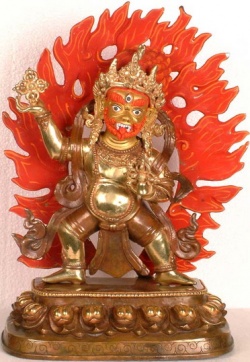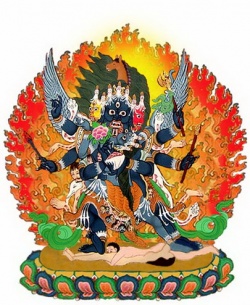Hayagriva Mantra
The XVIIth Karmapa has asked that Hayagriva mantras be accumulated, among others. Although it is not explicitly stated, the assumption is that he refers to Hrih Benza Trodha Hayagriva Hulu Hulu Hung Phat. If this is incorrect, someone please very quickly correct me.
I am also going to include a mantra associated with Ta Chag Khyung Sum, Hayagriva, Vajrapani, Garuda, as expressed in the "Molten Drop of Iron" branch of Kyabje Dudjom Rinpoche, Jigdrel Yeshe Dorje's New Treasure of the Extremely Wrathful Hayagriva. Because somebody is sure to comment or complain, I want to explain that I have received the associated empowerment for this three times, including once from Dudjom Rinpoche himself, and I clearly understand what is involved in making it public. There is more than one mantra associated with this particular practice. The mantra below is extremely powerful and efficacious in overcoming injuries, infections, and the threat of epidemic diseases -- a very real reflection of what is happening in Tibet right now. Dudjom Rinpoche is an ocean of compassion. It is my belief that he would be encouraging its use in the present circumstance.
Om Benzra Krodha Haya Griwa Benzrapanri Drom Garuda Yaksha Raksha Hung Phat.
If you want to criticize, go ahead and criticize. If your motivation is to criticize or find fault then it is my pleasure to oblige you. I have many faults, and they are not difficult to find. However, if your motivation is to do something to help the people who have been made to suffer by the recent earthquake in Tibet, the mantra I have published above has such power.
Most Secret Hayagriva Practice
For some of your projects to succeed, you need the power of controlling others (for the purpose of getting them to listen to you and obey you). I suggest you pray to Hayagriva for this. While the purpose of the Medicine Buddha practice is for general success, this practice is specifically for controlling specific purposes. Examples of how to use this practice are making prayers to Hayagriva and chanting a mala of the mantra before going to meetings. First, you generate as the deity, then visualize all the buddhas in the form of Hayagriva dissolving into you. At this time, generate the strong feeling of having received omniscience; great compassion for all sentient beings; perfect power to work for all sentient beings; and the power of control over others – for everyone to be under your control immediately in order to benefit the work for all sentient beings. Then others will like you a lot and agree with what you say.
You can meditate in different ways to control others. One is so that others think only of you; the second is to purify others first, and then bring them into your body; the third is receiving the perfect power of the deity for having the power of control. The third method is the most important. You should do this one the most.
Make strong prayers to Hayagriva when you have crucial meetings or are working on important projects. You can also recite the torma offering prayer to Hayagriva. You can do this the day before an important event and dedicate it to the success of the meeting or project. There are also praises to Hayagriva, and requests to overcome obstacles that you can recite.
You can also recite different mantras for success. You should do the Blessing of Speech in the morning. This will give power to your speech. Also, doing this practice will increase recitations of mantras by 10 million times. Even chatting becomes a recitation of mantras.
You can also recite the Mantra for All Success seven times a day:
TADYATHA NAKSHEDE SAPHA DITTHI MUTENA SHATRANI MESA MITA DAHNI BAHPHENTU SVAHA
Hinduism
Transcendental mantra of Lord Hayagriva from Hayagriva upanishad
Om srim hlaum om namo bhagavate hayagrivaya
vishnave mahyam medham prajnam prayaccha svaha
Obeisances to Lord Hayagriva, who is Vishnu. O Lord Hayagriva, please give me intelligence and wisdom. This is the 29 lettered Hayagriva mantra. Here, Om and Srim are two syllables. Hlaum is one syllables. Om namo bhagavate is seven syllables. Hayagrivaya is five syllables. Vishnave is three syllables.Mahyam medham prajnam is six syllables. Prayaccha svaha is five syllables.
sankha-cakra-maha-mudra-
pustakadhyam catur-bhujam
sampurna-candra-sankasam
hayagrivam upasmahe
Meditation
We worship Lord Hayagriva, who is splendid like the moon, and who holds a
conchshell, disc, maha-mudra, and book in His four arms.
Om srim hrim aim aim aim klim klim sauh sauhhrim om namo bhagavate hayagrivaya mahyam medham prajnam prayacchasvaha
Meaning : Obeisances to Lord Hayagriva. O Lord Hayagriva, please give me
intelligence and wisdom. This is the 28 lettered mantra of Hayagriva. Here, Om and Srim are two syllables. Hlaum is one syllables. Aim aim aim is three syllables. Klim klim is two syllables. Sauh sauh is two syllables. Hrim is one syllable. Om namo bhagavate is seven syllables. Hayagrivaya is five syllables. Mahyam medham prajnam is six syllables. Prayaccha svaha is five syllables.
Hloum Amrutham Kuru Swaha
This mantra when chanted repeatedly gives one mastery over words, wealth and the eight occult powers
Hloum (hsoum) Sakala Samrajya Sidhim Kuru Kuru Swaha
This mantra tells us the secret of the great Vedic sayings like “Pragnanam Anandam Brahma (Brahmam is the realized happiness)”, “Tat Tvam Asi (You are it)”, “Ayam Atma Brahma (My soul is Brahma)” and “Aham Brahmasmi (I am Brahmam)”. The same letter “Lhoum” and “hsoum” are the same vowels though different and give worldly pleasures and salvation respectively.
OM shrIM hlauM OM namo bhagavate hayagrIvAya rava rava rakSha rakSha huM phaT svAhA ||
namo .advidyA-bhakShakAya grasa grasa vapa vapa sphuTa sphuTa grasa hayagrIvAya svAhA | mahAbalAya sarva-j~nAna-netre svAhA |
om vanishwaraya vidmahe hayagrivaya dheemahetanno hamsat prachodayat


